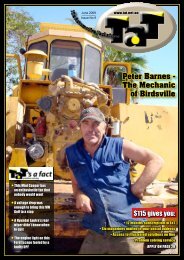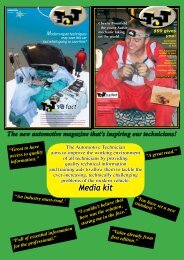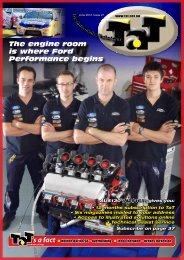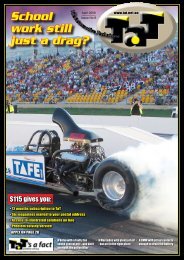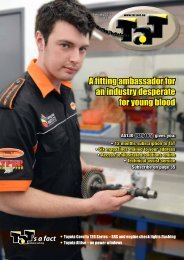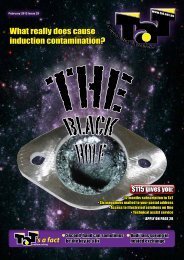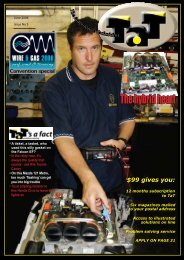Here - TAT - The Automotive Technician
Here - TAT - The Automotive Technician
Here - TAT - The Automotive Technician
Create successful ePaper yourself
Turn your PDF publications into a flip-book with our unique Google optimized e-Paper software.
Training event was a knock-out<br />
more please!<br />
Two groups of<br />
Australian auto<br />
technicians have<br />
just completed advanced<br />
workshops on electrical<br />
fault-finding with leading<br />
American specialist and<br />
trainer Dan Sullivan.<br />
Author of a 200-page<br />
electrical diagnostics book<br />
used in technical schools<br />
in the US, Dan has<br />
trained more than 4,000<br />
technicians since 1996.<br />
He is specifically skilled in<br />
electrical theory and practice. His training concepts are based on<br />
the peculiar nature of electrical systems, why they fail, and how<br />
they should be diagnosed.<br />
Dan was brought to Australia by electronic tools importer and<br />
wholesaler, Dayle Thomas of OLTC, for only two courses, one in<br />
Ipswich, Queensland and one in Murray Bridge, South Australia.<br />
TaT was well represented at both courses. Research director<br />
Deyan Barrie attended both, and TaT technical editor Jeff Smit<br />
and technical writer Jason Smith were in the South Australian<br />
audience.<br />
Both training sessions were highly successful and voted tops by<br />
all attendees.<br />
Deyan Barrie said he found the courses most rewarding, and that<br />
he learnt much from Dan’s training technique.<br />
<strong>The</strong> Queensland session was a full four days of learning about<br />
electrical circuits and how to diagnose faults correctly and<br />
efficiently. <strong>The</strong> South Australian session over two days at the<br />
Murray Bridge TAFE covered logical electrical trouble shooting.<br />
Organiser Dayle Thomas said his decision to bring Dan to<br />
Australia had been fully vindicated by the enthusiastic response<br />
to both sessions.<br />
‘<strong>The</strong> highlight for me was to see experienced technicians like<br />
Deyan Barrie rubbing shoulders with newcomers to the industry<br />
who barely understood multimeters and yet both technicians<br />
came away with new knowledge about testing and diagnosing<br />
faults in electrical circuits.’<br />
Jeff Smit, himself an accomplished technical teacher, was equally<br />
impressed. ‘Dan<br />
teaches that there are<br />
only three possible faults<br />
in an electrical circuit<br />
– open, short and high<br />
resistance.<br />
‘His training was<br />
hands-on and he had us<br />
working on training boards<br />
and constructing our own<br />
circuits to which faults<br />
were introduced – and<br />
then we had to diagnose<br />
those faults,’ Jeff added.<br />
TaT’s Jason Smith, from Melbourne, said he thoroughly enjoyed<br />
the training and picked up a lot of knowledge just by working<br />
together with other technicians.<br />
Other technicians said the training session had helped to push<br />
their thinking on electrical fault-finding in new directions, which<br />
would ultimately play out as time saved in the workshop.<br />
Trainer Dan told Jeff Smit that he would happily return to Australia<br />
as a result of the great feedback he received. He said he found<br />
Australian technicians worked quicker and seemed more<br />
confident than their American counterparts. He believed that<br />
those who rolled up to his Australian courses seemed surprised at<br />
how much they could do with their multimeters and the influence<br />
of ghost voltages.<br />
Given the warnings issued in another story in this issue, ‘Too<br />
many distractions’, TaT directors Jeff and Deyan, said that training<br />
events like Dan Sullivan’s should have been swamped with<br />
participants.<br />
‘Trainers should be turning people away,’ they said. ‘Instead, we<br />
often wonder if enough people will show up to justify the expense<br />
of putting them on.<br />
‘It’s also interesting to note that you will see the same faces at<br />
most training events. Organisations like VASA, for example, which<br />
has been running annual training events for many years, believes<br />
that 80 per cent of their audience are the same technicians who<br />
turn up year after year. <strong>The</strong>y never seem to tire of training, even<br />
though sometimes they’ve heard it all before.<br />
‘TaT is dedicated to training and is working at programs to<br />
encourage younger technicians to join in and discover what an<br />
exciting world automotive diagnostics can be,’ they said.<br />
practical theory<br />
hands on<br />
skills<br />
<strong>The</strong> <strong>Automotive</strong> <strong>Technician</strong> 32



